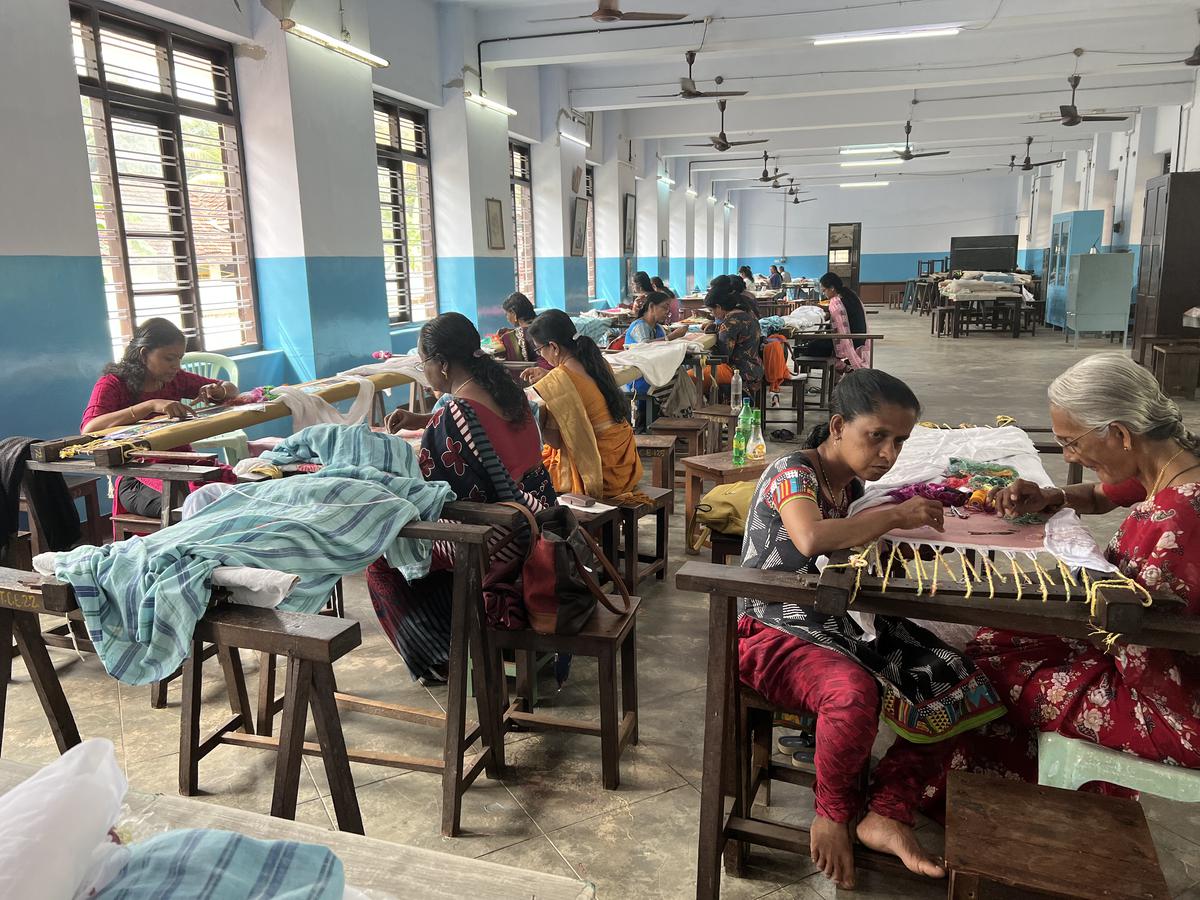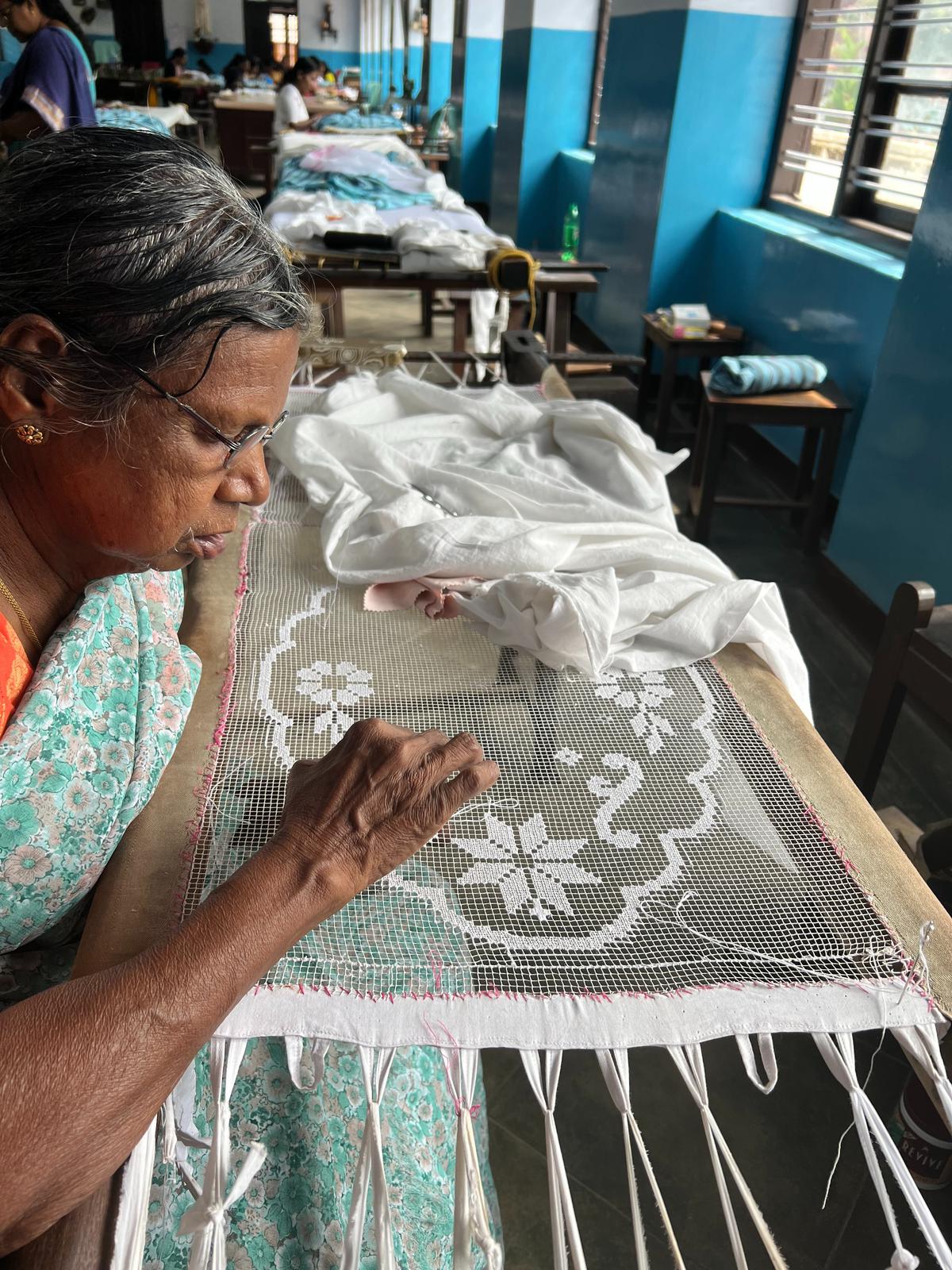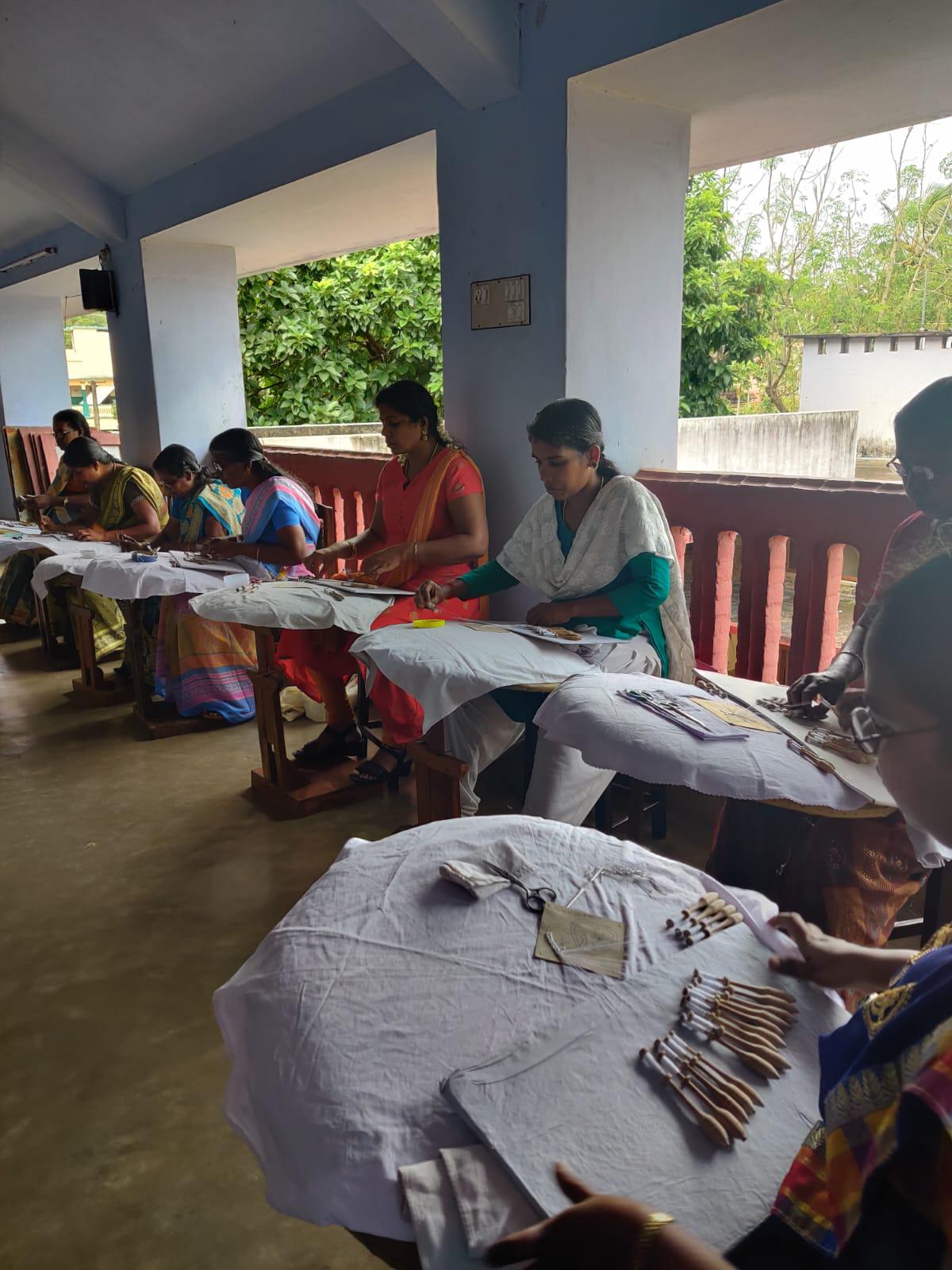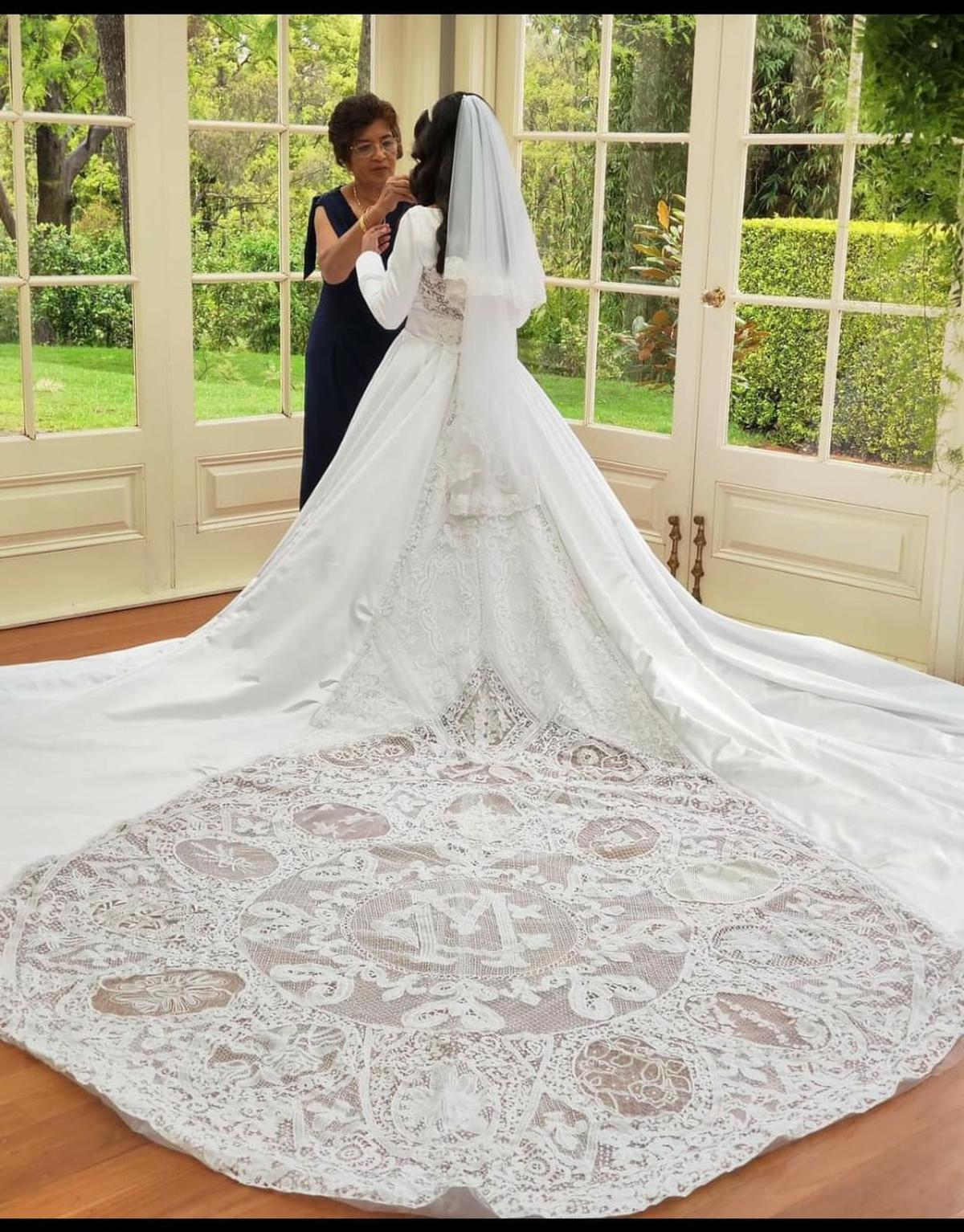Philomena is probably one of the Bruges lace makers in Kochi. The 78-year-old woman from Aroor is known for her intricate patterns using 26 bobbins. Lace-making and hand embroidery came to Kochi through missionary nuns and flourished in the city’s monasteries. While lace-making is nearly extinct, the art of embroidery is not only thriving, but has evolved from period motifs and a set clientele to contemporary designs and a global market.
St. Elizabeth’s Convent at Kattiparambu is one of the centers of lace making and embroidery. In an airy, spacious hall filled with sea breeze and bright sunlight, a group of women are immersed in embroidery patterns on cloth. In-charge Sister Teresa Varghese says, “The hall was full of girls earlier, but now there are only 35 girls.” “There are no lace makers anymore.” Established by the Franciscan Missionaries of Mary, this unit is “over 100 years old” and is the largest of the six units operated by the convent.
She recalls how, in the 1950s and 1960s, lace-making was flourishing in the city and girls and women from almost every household were engaged in it. They continued the art taught by European nuns and most homes have a curious set of wooden pins held pin by pin on a pillow. Until the 1970s and early 1990s, women in Kochi made Bruges lace, also known as bobbin or pillow lace.
Petit Point and more
But embroidery seems to have survived, be it petit point, shadow work, cross stitch and the rare filet work. These are in high demand and “we have to turn down customers. Where are the girls?” Sister Teresa asks.

Women doing embroidery at St. Elizabeth’s Convent in Kattiparambu, Kochi
Leena Joseph completes the nine-yard sari with a 3-inch border in Petit Point. The exquisite panel of colorful flowers, which will sell for ₹1,50,000, took five months to create and involved the work of 12 women. The most expensive is the eight-inch border, which sold for Rs 1,85,000.
Leena displays samples of the types of embroidery: a menorah or Jewish lamp stand in pink shade work, cross stitched flowers and petit point motifs spread on the fabric of the kurta. In a quiet corner, Jessie is engaged in the rare craft of making filet lace. Made on a knotted mesh, this type of lace is made using a long blunt needle and thread. “This art is also dying,” says Sister Teresa. “It requires special talent and it is not easy.” Jessie, from Manasseri, came to the unit at the age of 10 and Sister Teresa referred to her as a “treasure” for her good work and dedication.

Jessie making filet lace at St Elizabeth’s Convent in Kattiparambu, Kochi
Women have a sense of brotherhood. As they focus on their precise task, they pray in unison. According to Sister Teresa, their earnings depend on the number of hours they put in. “It can be between ₹3000 and ₹9000. Some only do three-hour shifts as they have to work at home as well.”
Lace making and embroidery were once practiced in Kanmali homes and convents. Tom Edwards, an entrepreneur in the region, says the decline is due to women moving into better-paying jobs. Another factor is the influx of machine-made but exquisitely embroidered pieces from China.
Read also: Reliving fond memories of Sarah Cohen
old world style
Little Queen Embroideries in Synagogue Lane in Jew Town displays exquisite lace-edged and embroidered handkerchiefs, dolly sets, runners, table mats, coasters, table cloths, frocks and kurtas. The fabric is largely pure white organdy set off by delicate old-world lace. “We set up this shop 50 years ago. Lace making is a dying art; We are reviving it by involving senior women who were once engaged in it,” says the proprietor, Thomas Pei, as he rattles off the names of various embroidery stitches: French knot, smoking, hardanger, herringbone stitch, button holes… Her unit Aroor employs 13 women. She points out that Bruges lace is also called Venetian lace and some designs use 28 or 42 or 68 or 86 bobbins. She worries the art will die , as the younger generation is looking for greener pastures.

Women making Bruges lace at the Infant Jesus Technical and Educational Institution in Mulagumoodu, Nagercoil.
Down the street from Thomas’ shop is Sarah Cohen’s embroidery shop. Sara Pardeshi was one of the Jews and she passed away in 2019 at the age of 96. She was known for her decorative Jewish embroidery. “Aunt Sarah used to embroider hats and scarves and holy clothes for the synagogue. Her sewing machine was given to her in 1943. I learned this art from him,” says his colleague Taha Ibrahim, since he was a boy. He showcases a variety of embroidery and lace items at the store, which he has collected from monasteries in Kerala, Tamil Nadu and Andhra. Traditional Jewish embroidered pieces, using golden thread, are showstoppers in the store.
Sandhya Gupta, who runs the embroidery factory, works with a number of embroiderers “chosen for their natural talent”. Sandhya, who moved to Kochi from Hyderabad 27 years ago, has a diverse range of clients spread across the US, UK and West Asia. “Kochi’s embroidery work is known for its exquisite craftsmanship,” she says. “Embroidery has always been a popular way to personalize clothing and accessories and people are using it to add their names, initials and even personal messages to their clothing and accessories.” She highlights surface ornamentation on western fabrics such as embroidery and bold bright colors in the introduction of geometric and abstract shapes and floral motifs. “It’s all very modern.”

A wedding gown trail in Bruges lace is made at the Infant Jesus Technical and Educational Institution, Mulagumdu
lace makers
The Bruges Lace products in the Kochi store mainly come from a convent in Mulagumoodu near Nagercoil in Tamil Nadu. During a phone conversation, Sister Selvi, administrator of the Infant Jesus Technical and Educational Institution, Mulagumoodu, says, “We have 85 women at our center and we have three teachers dedicated to teaching Bruges lace making. Our products are mainly sold to VTIs in Chennai and Kolkata and Ooty. Many boutiques and individual customers from Kochi purchase our products. We recently did a wedding saree for a client in Kochi. It took six months and 15 women to complete the 5.5 meter saree with complete lace. Its cost was ₹ 245,000.